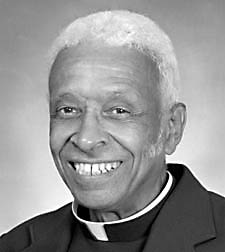By Bobby Ardoin (Opelousas Daily World)
OPELOUSAS, Louisiana – Father Jerome Ledoux, SVD, will be remembered as a man of faith, whose prolific religious writings, words of spiritual guidance and affable personality uplifted numerous African American Catholic church congregations across the South for more than six decades.
Father Ledoux, 88, who spent his final three years as a priest at Holy Ghost Catholic Church in Opelousas, was buried Wednesday at the St. Augustine Seminary in Bay St. Louis, Mississippi, where he began his religious training at age 13.
A large gathering filled the pews at Holy Ghost on Monday, January 14, for an afternoon visitation that included ceremonial prayers by the Knights of St. Peter Claver, followed by a Mass.
Many of those in attendance provided testimony about Father Ledoux, who died Jan. 7 at Lafayette General Hospital following a nearly month-long treatment for a heart ailment.
Father Ledoux’s ministry, which began in 1957 after his ordination, was often colorful and poignant, according to those who knew him during his various services at St. Augustine Catholic Church in New Orleans, Our Mother of Mercy Catholic Church in Fort Worth, Texas, and at Holy Ghost, whose estimated 2,500 congregation members comprise one of the nation’s largest African American Catholic churches in the U.S.
Until the time of his death, Father Ledoux was also a weekly contributor to publications across the U.S., including Mississippi Catholic.
Father Ledoux’s spiritual guidance and his availability to his parishioners was always legendary, said Robert Carmouche of Opelousas.
“He has been my inspiration. Despite his age, he was still working and that showed that if he could do that, I can too.
“I have kept all of his articles on religion and the e-mails that he would send to me and others in the church. They were wonderful and they addressed how to deal with life and death,” said Carmouche, a University of Louisiana at Lafayette faculty member and Holy Ghost parishioner.
Brenda Curtis, a cook and housekeeper at the Holy Ghost rectory across the street from the church, said Ledoux maintained a dedicated vegan diet. She described Father Ledoux as a “very religious man, an awesome preacher and a wonderful person who lived his faith.”
Curtis said that Father Ledoux’s meals normally consisted of beans, salads, vegetables and fruit. “Oh yes, all of the meals he ate were very healthy and all along he tried to teach us how to do that too,” she said.
Hazel Sias, a two-term St. Landry Parish school board members and Holy Ghost parishioner, said she originally met Father Ledoux years ago while she was visiting in New Orleans.
“He related to people so well. He lived a life of faith and always talked about God. He had the ability to draw people in to what he was saying to them. He could also sing. Sometimes when he’d want to start a song, then hold off, he would ask the pianist to hit a note and (Ledoux) wouldn’t start until the person got the note right.
“From talking with people I know that wherever he went, Father Ledoux’s church parishes loved him. For someone as old as he was, he was able to give advice that touched everyone, all generations,” said Sias.
Carmouche said that what made Ledoux’s communicative skills so effective was his overall demeanor.
“When you met him, you connected immediately because he was such a down-to-earth person. He came across as this normal person, who was also very religious, passionate about his faith.
“Father Ledoux had this unique way of preaching. He wouldn’t just stand in front of his people at church. He sometimes would move through the aisles and mix that presentation with psalms, some of which you could find in scripture and others that I think he must have made up on his own.
“He had this beautiful voice when he sang. It caught your attention and you wanted to join in,” Carmouche said.
Lena Charles, chairman of the Opelousas Downtown Development Authority, said despite his age, Father Ledoux never turned down a chance to speak with someone who needed his advice.
“He just loved people, loved his ministry. His words were always encouraging. The man also loved to write. He’s already written two published books with another that he was completing at the time of death.
“In one of (the books) he talked about his experiences in New Orleans with the church there and about (Hurricane) Katrina. They were all very interesting. When he got ready to write a column, he would send some of us a preview. We all knew how dedicated he was to his writing,” Charles said.
Carlton Jordan of Opelousas said he will never forget how Father Ledoux helped a family member with the death of a relative.
“I got to meet him when he was in Texas. It was then I really got to know him well and my first impression was he had the ability to lead people in the right direction,” Mouton said.
Carmouche said Father Ledoux’s inspiration throughout the church was evident, even despite the health issues.
“He always talked about the need to do something good for someone. What was impressive was how he was able to fight until the end. (Father Ledoux) was not afraid of death,” said Carmouche.
(Reprinted with permission from the Opelousas Daily World.)


